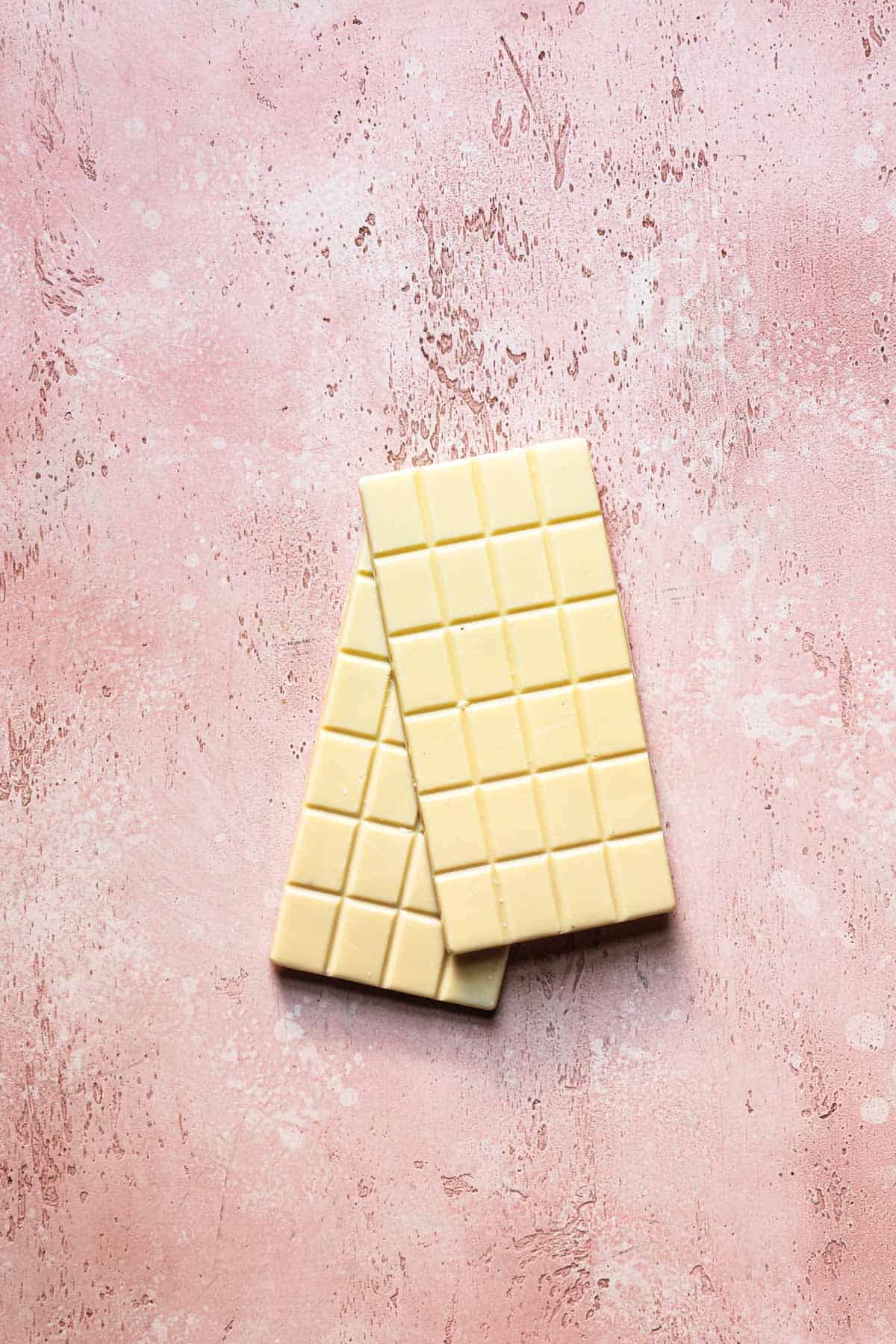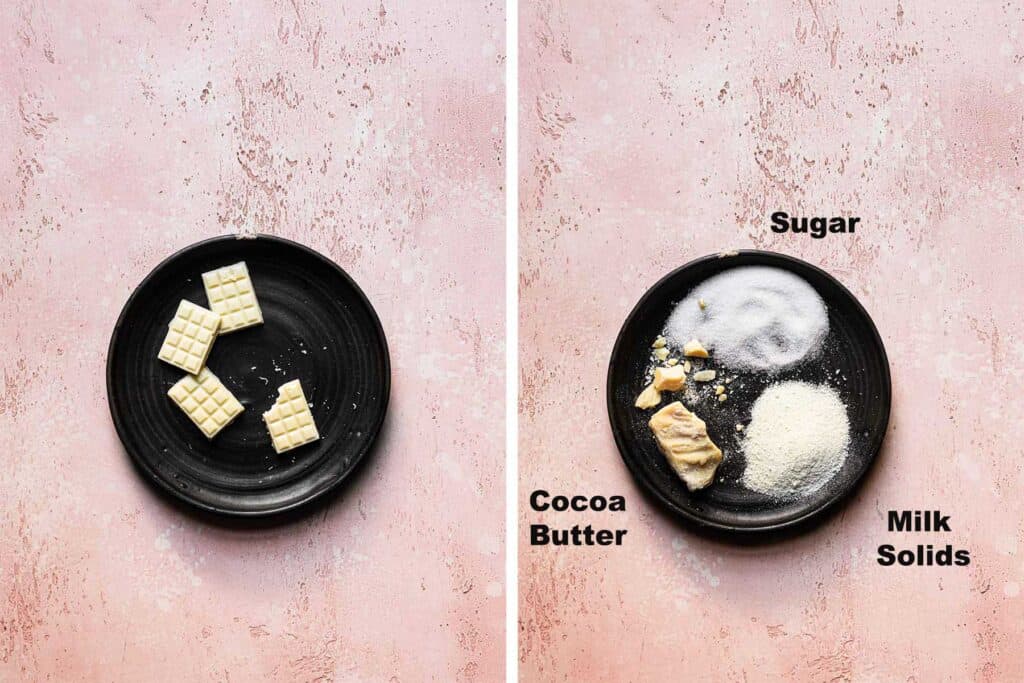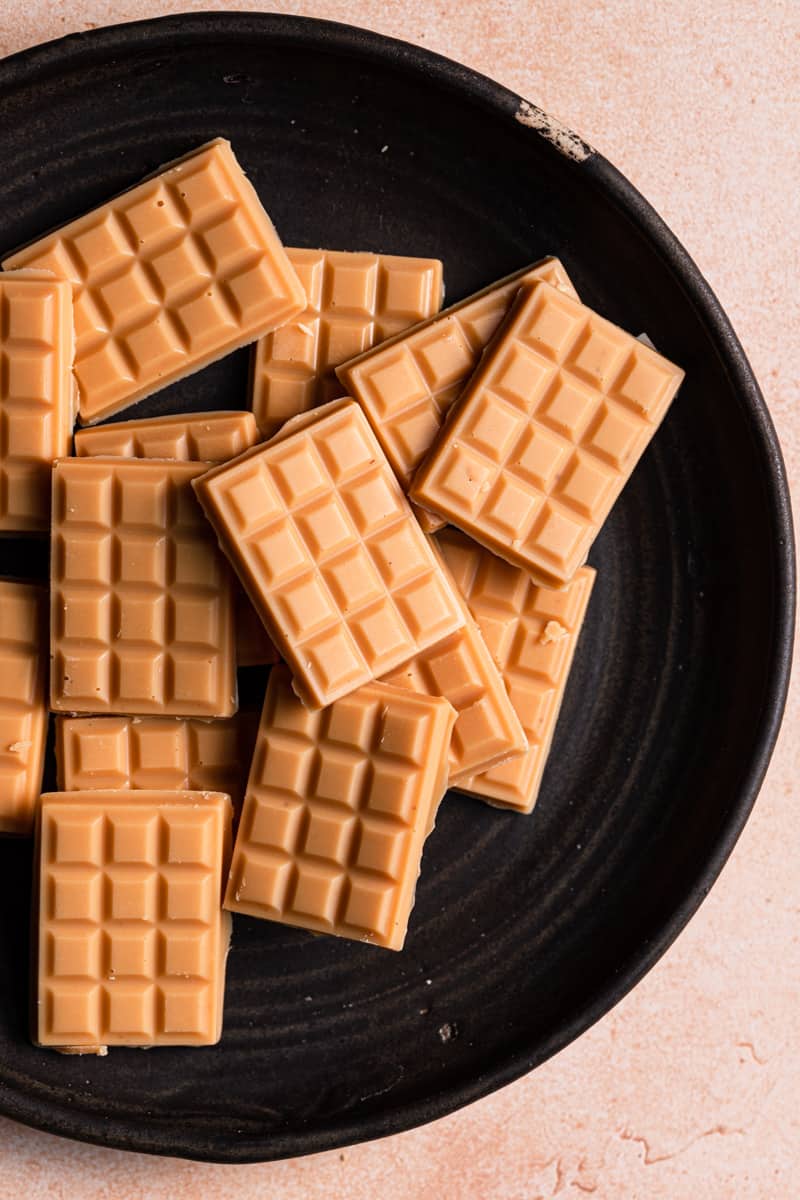Last updated on June 15th, 2025.
The answer to the question What Is White Chocolate may seem trivial, but chocolate connoisseurs worldwide have debated it for years.
You may have already made up your mind, which is fine. I am not here to change it, just to provide some facts for a deeper understanding that will eventually lead to better baking.

Is white chocolate real chocolate?
By law, yes. In the united states, the FDA legal definition (Food and Drug Administration) is that any product that contains 20 percent cocoa butter, 17.5 percent milk solids, and 55 percent sugar (sweeteners) is legally chocolate. Also, whenever we add sugar to processed cocoa beans, it is considered to be a chocolate product.
There is no chocolate in white chocolate. The name implies no cocoa solids or cocoa powder. This is why many chocolate fans and bakers do not consider it real chocolate, even though the process of making and tempering it is almost identical to the making and tempering of dark or milk chocolate bars.
Why is it called chocolate?
Because the key ingredient is cocoa butter, a fat driven from cocoa beans and also the key ingredient for all types of chocolate.
Also, I think it’s a marketing issue; a cocoa butter bar does not sound as sexy as white chocolate. And at the end of the day, it is a fantastic treat and a great way to incorporate flavor and texture into our baking.
What is white chocolate made of?
It depends on the brands, but for it to be legal, the ingredients in white chocolate are:
- Cocoa butter. At a minimum of 20%. Note that it does not represent the fat content because other types of fat, such as vegetable oil or palm oil may also be present.
- Milk solids. At a minimum of 17.5%
- Sugar (or any other sweeteners). No more than 55%.
A white chocolate bar usually contains about 4 percent milk fat, lecithin, and vanilla extract.

How Is It Made?
The cacao nibs (cacao beans that have been roasted) are pressed and release a warm liquid called chocolate liquor (AKA unsweetened chocolate), which is made of cocoa butter and cocoa solids. Then, the cocoa butter is separated from the cocoa solids. Cocoa solids are used to make cocoa powder. Milk solids, sugar (and other ingredients) are mixed with the cocoa butter, and together they are processed and tempered into white chocolate products.
Who Invented It?
The official developer is Hershey’s, back in the last 1920s. They wanted to take advantage of the leftover cocoa butter from cocoa powder production, so a new product was born and introduced to the market in 1930.
What Does White Chocolate Taste Like, and what is the point of it?
It tastes like sweet fresh milk; its pale ivory yellow color does not imply it has a vanilla flavor. Because it’s rich in milk solids and sometimes other milk products, it has a fresh taste. This is why it pairs well with flavors like Raspberries, passion fruit, and even licorice.
Baking With White Chocolate
You don’t have to be a die-hard white chocolate fan to enjoy baking with it. Here are the reasons why I love baking with it:
- Flavor. Its unique flavor can help enhance vanilla flavor and help balance other sour or bitter flavors like passion fruit and grapefruits.
- Texture. It is rich in cocoa fat, melting at body temperature, making it easy to melt and incorporate into our baked goods.
- Color. Unlike brown chocolate, it’s light and can blend well with any color without overpowering it.
Baking Tips
Most times, when we bake with white chocolate, we do it to add the unique milky flavor it has. But it is important to remember that when we mix it into our recipe, we add other ingredients such as fat, sugar, and milk solids, so if you want to make any changes to the recipe, keep that in mind. Know that real white chocolate has a pale ivory color; a bright white indicates that it is fake chocolate.
- Fat. Even though it is not the main ingredient by weight, it is perhaps the most important one because it is the difference between real and fake chocolate. To know if your chocolate is real or fake, look at the ingredients list; if cocoa powder is the first or second ingredient, it is real. If it’s other types of fat, such as palm kernel oil or other vegetable fat, it’s fake chocolate. Cocoa butter’s melting point is as low as our body’s temperature, which means it will start to melt and dissolve as we bite it. Other fats have a much higher melting point and will not melt as quickly or pleasantly.
- Sugar. It can be up to 55% of added sugar; it’s a good idea to remember that when developing or making changes to a recipe. If removing it altogether from the formula, consider increasing sugar. If you plan to add it to a recipe, think about using less sugar or a source of acid to balance the sweetness.
- Milk Solids. It is what gives the subtle yet, distinguished dairy milk flavor and unique white chocolate taste. Since it is a must by the FDA definition and legal standards, it is not vegan. To enhance the flavor, consider adding 1-2 tablespoons of dry milk powder to your recipes.
- Other Ingredients. Most brands add lecithin as an emulsifier and as a way to increase the cream texture. Other ingredients, such as vanilla extract or flavoring agents, are also added.
Caramelized White Chocolate Explained
Since there is no cocoa powder, we can bake white chocolate and raise its temperature to 266F (130C), allow the browning process to begin, and develop beautiful light golden color along with deep rich flavors.
To do that, chop the chocolate and place it in an even layer over a baking sheet lined with parchment paper. Then bake it at 225F (107C), using a rubber spatula to stir every 15 minutes until the chocolate is completely melted and golden brown. Remove from the oven, drizzle into chocolate molds, allow it to set, or temper it.
Use it for any recipe, even to make Caramelized White Chocolate Milk.
Note that once caramelized, it will no longer be tempered chocolate. To temper, it check out my post about How To Temper Chocolate.

Soring
The cocoa butter content is why our bars melt in the mouth, why they snap when we break them and why they have a creamy texture. It also has the same phase behavior as other types of chocolate. This means it will have different properties at different temperatures. For example, it has a mealy unpleasant texture at a temperature range of 61-64F (16-18). Store it at room temperature to maintain its ideal properties (or 26-28 C / 78.9-82.4 F, to be exact).
Ideas And Recipes
Bake this Raspberry cake loaf, White Forest Cake, Marble Cake, white chocolate raspberry muffins, and even Ganache. You can also sprinkle white chocolate chips into these delicious Triple Chocolate Cookies or this Brownie Pizza.
I hope you enjoyed this article. And please feel free to leave a comment with your questions at the bottom of this page.
If you are curious about baking, check out my other articles that answer your baking questions.

